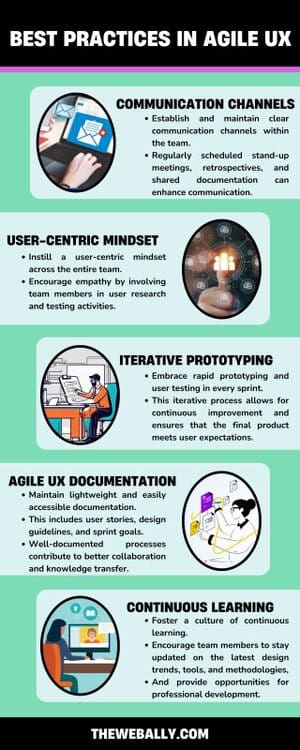Agile User Experience (Agile UX) is a methodology that integrates principles of Agile development with user-centered design principles to create a seamless and efficient product development process.
In the ever-evolving landscape of technology and user expectations, Agile UX has become a crucial approach for teams seeking to deliver user-centric and high-quality products.
This complete guide explores the foundations, principles, and best practices of Agile UX in 2024.
Below are the important concepts helpful in understanding the agile development process.
Agile development originated in the software industry and is characterized by iterative development, collaboration, and flexibility.
Agile UX extends these principles to the user experience design process, emphasizing adaptability and responsiveness to change.
At the core of Agile UX is the commitment to user-centered design.
This involves understanding the needs, behaviors, and preferences of end-users through continuous feedback, user testing, and collaboration.
Iterative Design: Agile UX promotes an iterative design process, allowing teams to continuously refine and improve the product based on user feedback.
Collaboration: Cross-functional collaboration is essential in Agile UX, involving designers, developers, product managers, and stakeholders working together throughout the entire project lifecycle.
Adaptability: Agile UX embraces change and welcomes it as an opportunity for improvement. Teams should be flexible and able to adjust their strategies based on evolving requirements.

Here are the main characteristics of the agile development process:
Agile UX divides the project into small, manageable iterations called sprints. Each sprint typically lasts 1-4 weeks, during which a specific set of features is designed, developed, and tested.
User stories, short narratives that describe a specific user’s goals and tasks, are used to guide design decisions. Persona development helps create a shared understanding of the target audience and their needs.
Design thinking methodologies, such as empathy mapping and journey mapping, are crucial in understanding user needs and creating innovative solutions.
Rapid prototyping is a key aspect of Agile UX, allowing teams to quickly create low-fidelity prototypes for testing and validation.
Usability testing is conducted regularly to gather user feedback and inform design decisions.
The following are the main tools that help in the creation of the agile development process:
Tools like Slack, Microsoft Teams, and Trello facilitate communication and collaboration among team members, ensuring everyone is on the same page.
Prototyping tools like Sketch, Figma, and Adobe XD enable designers to create interactive prototypes for user testing and validation.
Version control systems such as Git are essential for tracking changes and managing collaboration among developers and designers.
Like any other field, Agile Development comes with certain challenges, these include:
By using the following techniques, you can expect to generate the best results during your agile development process:
Establish and maintain clear communication channels within the team. Regularly scheduled stand-up meetings, retrospectives, and shared documentation can enhance communication.
Instill a user-centric mindset across the entire team. Encourage empathy by involving team members in user research and testing activities.
Embrace rapid prototyping and user testing in every sprint. This iterative process allows for continuous improvement and ensures that the final product meets user expectations.
Conduct regular retrospectives at the end of each sprint to reflect on what went well, what could be improved, and how to implement those improvements in the next iteration.
Encourage cross-functional training to promote a better understanding of each team member’s role. This facilitates smoother collaboration and a more holistic approach to problem-solving.
Maintain lightweight and easily accessible documentation. This includes user stories, design guidelines, and sprint goals. Well-documented processes contribute to better collaboration and knowledge transfer.
Foster a culture of continuous learning. Encourage team members to stay updated on the latest design trends, tools, and methodologies, and provide opportunities for professional development.
Strike a balance between adaptability and structure. While Agile emphasizes flexibility, having a defined framework and process helps maintain a sense of order and predictability.
By addressing these challenges and adopting these best practices, Agile UX teams can enhance their ability to deliver user-centered products iteratively and collaboratively, ultimately leading to more successful and satisfying user experiences.
In 2024, Agile UX continues to be a transformative approach, aligning design and development teams to deliver user-centric products efficiently.
By embracing collaboration, iteration, and adaptability, Agile UX enables organizations to stay responsive to user needs in an ever-changing technological landscape.
As the digital ecosystem evolves, the principles and practices outlined in this guide provide a foundation for successful Agile UX implementation.
If you need help in creating the right UX for your digital brand assets, The Web Ally can help you. Contact us today and we can provide you with a customized solution.
Self-service covers every aspect of life these days, but we still believe in the power of having someone to talk to. Maybe it's to bounce off ideas and explore new opportunities. Maybe it's just to say hello.
In any case, we will only use your contact details to get in touch with you regarding your enquiry - and nothing else!